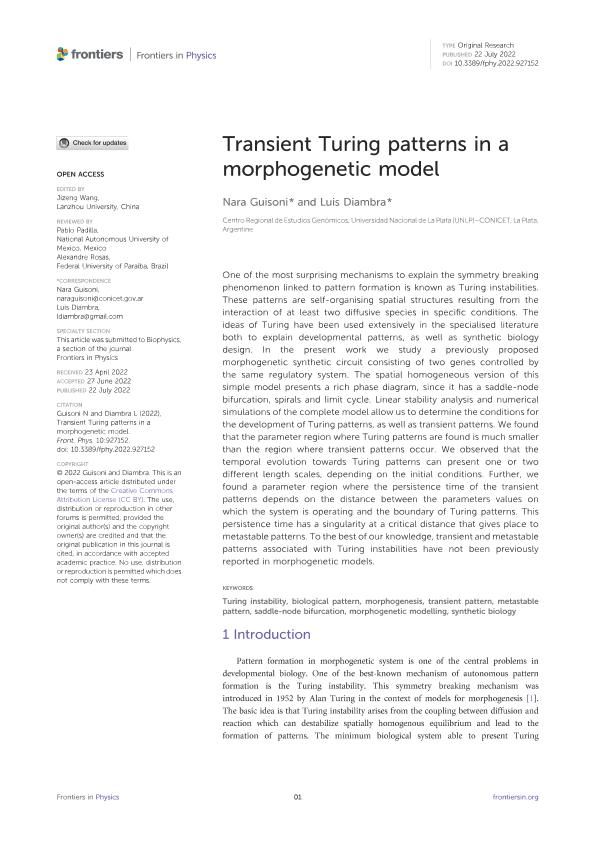Mostrar el registro sencillo del ítem
dc.contributor.author
Guisoni, Nara Cristina

dc.contributor.author
Diambra, Luis Anibal

dc.date.available
2023-07-31T18:47:11Z
dc.date.issued
2022-07
dc.identifier.citation
Guisoni, Nara Cristina; Diambra, Luis Anibal; Transient turing patterns in a morphogenetic model; Frontiers Media S. A.; Frontiers in Physics; 10; 7-2022; 1-13
dc.identifier.uri
http://hdl.handle.net/11336/206252
dc.description.abstract
One of the most surprising mechanisms to explain the symmetry breaking phenomenon linked to pattern formation is known as Turing instabilities. These patterns are self-organising spatial structures resulting from the interaction of at least two diffusive species in specific conditions. The ideas of Turing have been used extensively in the specialised literature both to explain developmental patterns, as well as synthetic biology design. In the present work we study a previously proposed morphogenetic synthetic circuit consisting of two genes controlled by the same regulatory system. The spatial homogeneous version of this simple model presents a rich phase diagram, since it has a saddle-node bifurcation, spirals and limit cycle. Linear stability analysis and numerical simulations of the complete model allow us to determine the conditions for the development of Turing patterns, as well as transient patterns. We found that the parameter region where Turing patterns are found is much smaller than the region where transient patterns occur. We observed that the temporal evolution towards Turing patterns can present one or two different length scales, depending on the initial conditions. Further, we found a parameter region where the persistence time of the transient patterns depends on the distance between the parameters values on which the system is operating and the boundary of Turing patterns. This persistence time has a singularity at a critical distance that gives place to metastable patterns. To the best of our knowledge, transient and metastable patterns associated with Turing instabilities have not been previously reported in morphogenetic models.
dc.format
application/pdf
dc.language.iso
eng
dc.publisher
Frontiers Media S. A.
dc.rights
info:eu-repo/semantics/openAccess
dc.rights.uri
https://creativecommons.org/licenses/by/2.5/ar/
dc.subject
BIOLOGICAL PATTERN
dc.subject
METASTABLE PATTERN
dc.subject
MORPHOGENESIS
dc.subject
MORPHOGENETIC MODELLING
dc.subject
SADDLE-NODE BIFURCATION
dc.subject
SYNTHETIC BIOLOGY
dc.subject
TRANSIENT PATTERN
dc.subject
TURING INSTABILITY
dc.subject.classification
Otras Ciencias Físicas

dc.subject.classification
Ciencias Físicas

dc.subject.classification
CIENCIAS NATURALES Y EXACTAS

dc.title
Transient turing patterns in a morphogenetic model
dc.type
info:eu-repo/semantics/article
dc.type
info:ar-repo/semantics/artículo
dc.type
info:eu-repo/semantics/publishedVersion
dc.date.updated
2023-02-09T15:16:23Z
dc.identifier.eissn
2296-424X
dc.journal.volume
10
dc.journal.pagination
1-13
dc.journal.pais
Suiza

dc.description.fil
Fil: Guisoni, Nara Cristina. Universidad Nacional de La Plata. Centro Regional de Estudios Genómicos; Argentina. Consejo Nacional de Investigaciones Científicas y Técnicas. Centro Científico Tecnológico Conicet - La Plata. Instituto de Investigaciones Fisicoquímicas Teóricas y Aplicadas. Universidad Nacional de La Plata. Facultad de Ciencias Exactas. Instituto de Investigaciones Fisicoquímicas Teóricas y Aplicadas; Argentina
dc.description.fil
Fil: Diambra, Luis Anibal. Universidad Nacional de La Plata. Centro Regional de Estudios Genómicos; Argentina. Consejo Nacional de Investigaciones Científicas y Técnicas. Centro Científico Tecnológico Conicet - La Plata; Argentina
dc.journal.title
Frontiers in Physics
dc.relation.alternativeid
info:eu-repo/semantics/altIdentifier/doi/https://doi.org/10.3389/fphy.2022.927152
dc.relation.alternativeid
info:eu-repo/semantics/altIdentifier/url/https://www.frontiersin.org/articles/10.3389/fphy.2022.927152/full
Archivos asociados
